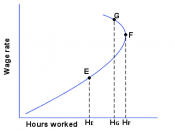Labour economics hunts for to realize the functioning and dynamics of the market for labour. Labour markets function through the interaction of employees and employers. Labour economics examines at the suppliers of work services (workers), the demanders of work services (employers), and endeavors to realize the producing pattern of salaries, paid work, and income.
In economics, labour (or labour) is an evaluation of the work wrapped up by human beings. It is conventionally compared with such other factors of production as land and capital. There are models which have deduced a fundamental thought called human capital (referring to the talents that staff have, not likely their real work), though there are in addition act against faking macro-economic procedure models that consider human capital is a contradiction in terms. (Deery, S, Plowman, D, Walsh, J & Brown, 78)The Reserve Bank of Australia's (RBA) glossary of terms, defines labour market as "A collective term for employment, unemployment, participation rates and wages."
Additionally it may be defined as the interaction between employees and employers and how they seek to find employment, also the effects of trade unions and Industrial Tribunals and how they aim to protect and assist workers. (Sandra Jones, 153) The labour market throughout the years has shown trends or patterns in its changes, this can be seen by studying the statistics of factors of the labour market such as: Unemployment, part time work, casualization of work, outsourcing, individual contracts and sub-contracting.
Unemployment is defined as a person that is not working, but is seeking for and is readily available to work. Causes of unemployment can vary from lack of education to discrimination in the workplace. Unemployment for the last 10 years has dropped at a low but steady rate to just settle at 4.9% at the current state according to...


